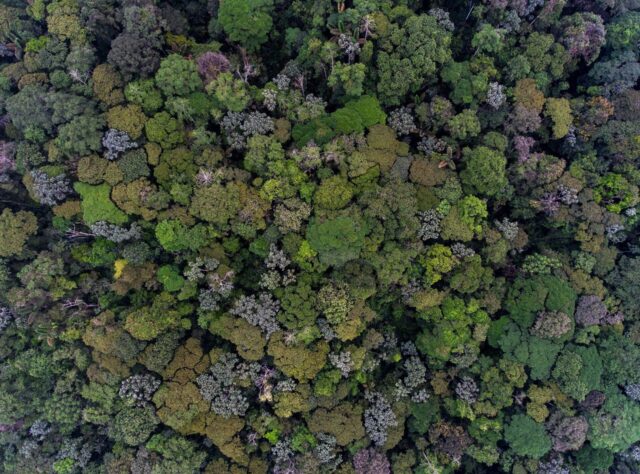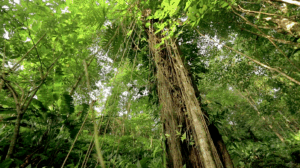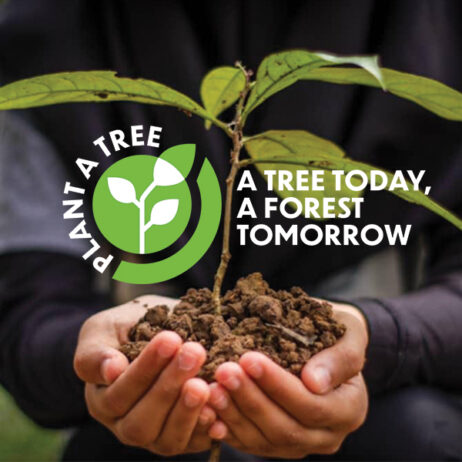
An aerial view of the canopy in Ecuador's Canande Reserve. Credit: James Muchmore
By Dr Catherine Barnard, World Land Trust (WLT) CEO
A recently published paper “Are Carbon Offset Fixable?” out of Oxford University has once again called into question the effectiveness of carbon offsetting in the context of reducing atmospheric carbon levels at a global scale. The review paper, which looked at 25 years of evidence, discusses common issues with carbon credit schemes such as difficulties in properly quantifying the amount of carbon offset by projects, which the paper states can lead to over-estimating, double counting, and permanence.
It is true that these are all issues that can occur with any project. However, I still maintain that the basic premise of carbon credits as initially conceived was, and remains, a sound one. Countries should be paid to protect standing forests, and carbon credits are an attempt to transfer capital to do so. This capital is particularly important given the context that such forests are almost always situated in lower income countries with lower global carbon emissions and they deserve to be compensated by the higher income countries that have disproportionate impact on greenhouse gas emissions.
The problems highlighted in this paper are also common with many, if not all, voluntary certification schemes. Especially as there has been a rapid adoption of these schemes by those with commercial interests who identified the opportunity for profit from these in the absence of a global regulatory framework. The potential for poor quality credits was obvious to most of us from the outset from schemes such as renewables, for which the business case existed irrespective of carbon markets so there was no need for further incentives. Meanwhile, the potential for providing funding for protection of standing forests for which the only existing business case was deforestation and conversion was enormous. The problem therefore is not one of carbon credits being a bad idea, but rather one of a good idea that capital markets can abuse for profit in the absence of regulation.
It is always, by definition, impossible to prove a counterfactual, but our experiences, and my personal experience, convince me that there are a number of excellent REDD+ and reforestation projects run by non-profit civil society and community groups. These projects protect forests for which there was previously no incentive to protect, nor any disincentive to deforest. I know there are forests standing today that would not be doing so without the carbon funding that has been made available. There are also threatened species whose homes are protected. In WLT’s Carbon Balanced project areas alone, more than 1,600 species of fauna are protected, and those are just the recorded ones. Alongside this, there are local people who are receiving incomes. We are aligned with the paper’s recommendations to prioritise reducing emissions first and only after that transitioning to durable carbon reductions and removal for any residual emissions. Carbon offsetting is, and must not be, not a ‘get out of jail free’ card for carbon emissions but rather a way of supporting and financing the protection of standing forests with all the benefits that brings, carbon capture and storage being just one of them, but one that brings the necessary financing.

WLT’s Carbon Balanced projects are rigorously selected to deliver benefits for both wildlife and local communities, as here in Caribbean Guatemala. Credit: FUNDAECO
In all these cases it is impossible to prove what would have happened without carbon credit financing, although local knowledge makes it clear what would likely have happened. It is also impossible to prove that leakage hasn’t happened, but good projects are based on robust monitoring that would quickly raise questions if that seemed to be the case. Likewise, good projects hold large buffers against the risk of permanence, and where they are run by non-profits, will restore any areas damaged by wildfires for example.
Voluntary carbon credits aren’t a panacea. We need systemic change that properly accounts for the value of nature in our economic models. But systemic change is difficult, and recent events make such a paradigm shift seem unlikely in my lifetime. However, the best carbon credits have been a stepping stone that has protected some of the most important places on this planet, and by attacking the concept, rather than the players who have abused it, runs the risk of further reducing vital funding for forest conservation and restoration.
By all means challenge the projects and their efficacy; this is too important to get wrong. But perhaps the spotlight needs to be shone more on the commercial operators in this space and how they have taken advantage of the unregulated system rather than tarring all projects with the same brush. This is crucial not least because the newer alternative methods being touted as the key to net zero such as carbon capture and storage technology risk encountering the exact same issues in the absence of regulation.
We need systemic change, but in the meantime, we must not let perfection be the enemy of the good. Time is against us in the race against climate collapse.

